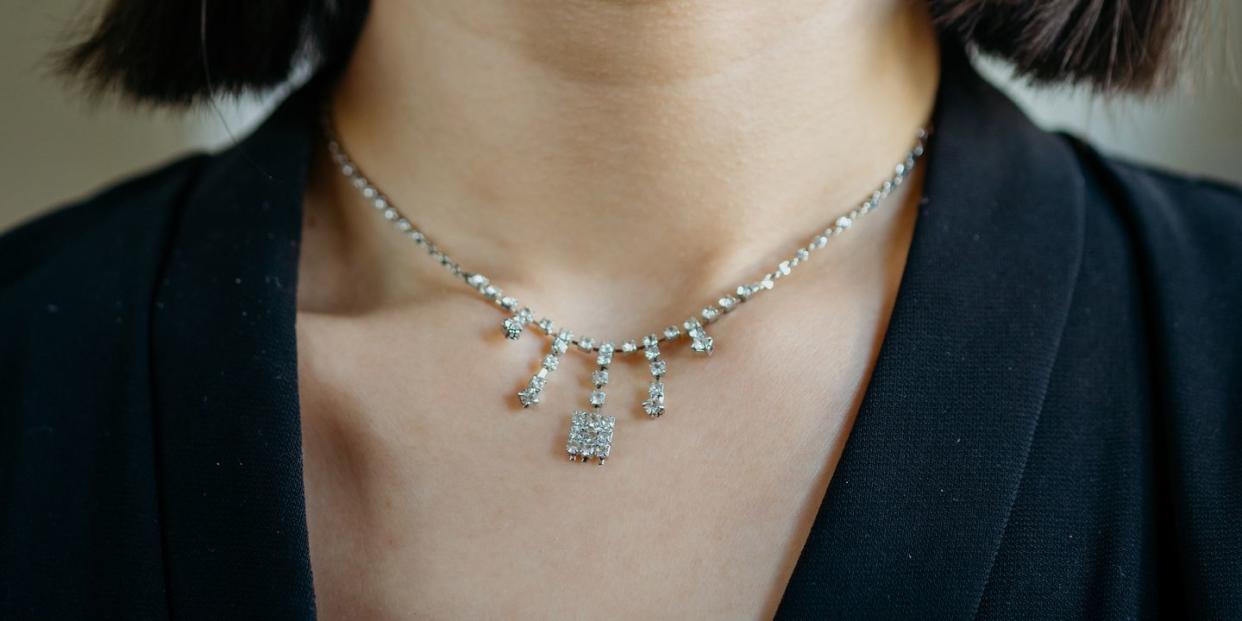This Is How You Can Tell if a Diamond Is Real, According to an Expert

"Hearst Magazines and Yahoo may earn commission or revenue on some items through these links."
Marilyn Monroe famously sang, “Diamonds are a girl’s best friend.” However, she didn't specify what kind of diamond.
There are three diamond categories to consider when investing in a stone for an engagement ring or another type of jewelry: natural, lab-grown, and cubic zirconia. They all look nearly identical to the naked eye because their differences are so slight. However, there are some detectable distinctions between these subcategories if you know what to look for.
In some cases, you can learn how to tell if a diamond is real or manufactured without consulting a jeweler, although getting a professional to examine the stone is always the safest bet. Here's what you need to know about their different types and how to tell if a diamond is real.
What is a natural diamond?
Natural diamonds are "formed deep within the Earth's crust over billions of years of intense heat and pressure," says Olivia Landau, the founder and CEO of The Clear Cut.
Natural diamonds are mined via alluvial mining (extracted from sand and mud along riverbanks), marine mining (extracted from the seafloor), and pipe mining (extracted from pipe deposits in the ground). This is done all over the world, though gemologist Hobart M. King, Ph.D. told Geology.com that few diamonds are domestically produced in the United States. Once extracted from the ground, diamonds are cleaned and then cut into the gems you find at the jeweler.
What is a lab-grown diamond?
A lab-grown diamond is exactly what it sounds like, a diamond manufactured in a lab by scientists. While these stones aren’t mined like natural diamonds are, Landau notes they are constructed from natural materials — specifically coal and gas. They're then generated through "a highly energy-intensive process" called Chemical Vapor Deposition (CVD) or High-Pressure High Temperature (HPHT).
Because lab-grown diamonds are manufactured instead of mined, they’re significantly less expensive than natural diamonds. Think a couple of hundred dollars per carat vs. tens of thousands.
What is a cubic zirconia diamond?
Like lab-grown diamonds, cubic zirconia diamonds are also man-made stones. However, unlike a lab-grown diamond, cubic zirconia is made from Zirconium dioxide, a white, crystallized powder form of the metal zirconium. It's a synthetic diamond simulant (or substitute) designed to pass as the real thing. Essentially, it’s a gemstone, but it’s not a diamond. "They are very inexpensive and have no inherent value," Landau tells us.
How to tell if a diamond is real
Time will give it away
If you’re curious about diamond-like pieces in your jewelry collection that you’ve had for a long time, Landau says that one obvious tell is to look at how the stone has held up over the years. Cubic zirconia diamonds lack the same optical properties of a natural diamond and are softer, so they’re more fragile, she explains. "As a result, they may scratch or lose luster over time."
Man-made diamonds are shaped differently
According to a report published by the National Diamond Council, natural diamonds have more variation in their shape and grain patterns than manufactured stones that are cut to precision.
Typically, natural diamonds are octahedrons, meaning a shape with eight plane faces, whereas lab-grown diamonds are cuboctahedrons (a shape with 14 plane faces — eight triangular and six square), and cubic zirconia diamonds are shaped like a cube.
Note how the stone is described
Whether you’re reading product descriptions online or talking with a seller directly, take note of how the diamond is described.
Per the National Diamond Council, global standards and national legislation state that the word "diamond" used on its own always implies a natural diamond, while diamonds made in laboratories will be described in terms such as "synthetic diamonds," "laboratory-grown diamonds," and "laboratory-created diamonds."
Try fogging it up
One of the easiest ways to tell if a diamond is real, per The Diamond Pro, is to hold the stone between two fingers and breathe on it. Just one or a few good puffs will do the trick.
Your jewelry is bound to fog up a little, but how long it stays fogged up is telling: Fog will clear up quickly on a real diamond, but stick around for a few seconds on a fake one.
Bring it to a jeweler
OK, we know you said you can skip this step, but the guaranteed way to tell if a diamond is real is to take it to a professional, says Landau. Gemologists use over 40 instruments for testing and examining stones. And according to the National Diamond Council, these tools assess the gem’s composition, grain patterns, reaction to fluorescence, quality, and growth, among other attributes.
For those who want to leave nothing to chance, going to a pro will give you the most accurate read on what type of stone you have.
You Might Also Like

